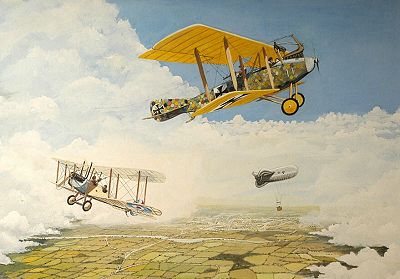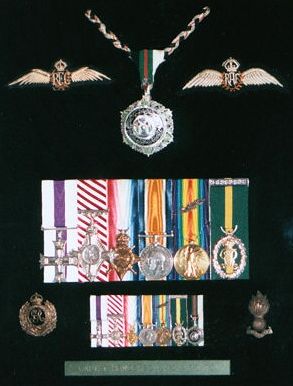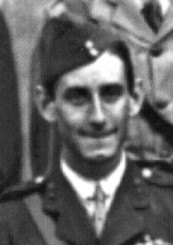A short history
Attested into the Tyne Electrical Engineers (Territorial Forces) in 1912. On the outbreak of war he was commissioned and transferred to the Royal Flying Corps. He trained as an observer and saw action with 10 Squadron RFC in France for which he qualified for his 1914-15 star.
He then did flying training at Catterick and passed as a pilot on 10.2.16 with his Royal Aero Club Certificate 2430. He then went to Egypt and joined 14 Sqn. RFC in time to join the Hejaz Expedition. Here he was awarded his M.C. "For flying services in the Hejaz 1916-17".
|
 The Albatross attack in a painting by Geoff Bell.
The Albatross attack in a painting by Geoff Bell.
(Photograph - Simon Clay)
|
During one flight over Lille he was involved in a skirmish with a German Albatross and as a result his plane was forced to land with damage to the propeller and fuel tank.
In his combat report he describes the events of the day in more detail, but as the original report is difficult to read I have included a transcript to make things easier.
He returned to the UK from Egypt and wrote the narrative of the Hejaz Expedition for the War Office. The narrative was presented to Col. Joyce and eventually with the collection of his documents passed on to the Library of The Imperial War Museum. The carbon copy was kept by Henderson as his private copy including the note left by Lt. W.G.Stafford, which is recorded in "The Official History of the War in the Air".
|
Albatross
Fitted with Machine Gun
(Gunner behind Pilot) Whilst taking photographs of the Lille defences, an Albatross - armed with a machine gun - suddenly made its presence known to us by swooping down & firing several rounds at our machine from behind.
Our Lewis gun being all ready for firing, we immediately turned about & made for him & on passing him, fired off about 25 rounds at a range of 20 yds.
He manoeuvring quicker than we took the offensive once more; we in return fired the remainder of the drum into him from behind. He again turned, while I replaced another drum of ammunition. This time he passed quite closely above us, but did not fire. We turning about now took the offensive & passing him on our left fired several shots. He now appeared to fire with greater judgement with the result that our front petrol tank, propeller, & parts of the fuselage were hit. This damage necessitated return to earth as soon as possible, so we therefore gave up the combat and made for our own lines.
|
After the war he joined 58 Sqn RAF and flew as a Flight Commander, one of 51 Handley Page bombers that flew to Egypt in 1919. For this he was awarded his A.F.C. He also met up once more with T.E. Lawrence whom he flew as a passenger on several of the short hops (300 miles approximately) between the Belgian and French border where 58 Sqn and the squadrons involved were based and Egypt.
In 1920 Henderson wrote his "Indian and Middle East Narrative" which was his personal account of the preceding 12 months in Mesopotamia.
After 20 year's service, with war years counting double, he was awarded his Territorial Decoration.
In 1927 at "His own request" he resigned from the Royal Air Force.
When Lawrence of Arabia died in 1935, Henderson attended the funeral at Moreton and also the memorial to Lawrence in St. Paul's Cathedral. It was in this same year on the 21st of May that Captain Henderson recalls his memories of Lawrence in an interview with The Bournmouth Daily Echo.
He was also invited by A.W. Lawrence to write a chapter in the book T.E. Lawrence by his Friends that his brother published after the death of his brother. For this Henderson was presented with a copy of Seven Pillars of Wisdom.
After the war he married Lesley Deucher of the family that owned the brewery that produces Newcastle Brown Ale.
Thomas Henderson returned to Tynemouth and resided there when he died in 1945. He is buried in the family grave at St. Mary's Church Whitley Bay.
Awards and decorations
|

|
- Military Cross
London Gazette 8th. August 1917 page 8105.
For flying services in Arabia. Hejaz Expedition 1916-17
(Cross privately engraved)
- Air Force Cross
London Gazette 12th. July 1920, page 7422.
Awarded for being 'B' Flight Commander of 58 Squadron
when on the pioneering flight from France to Egypt in 1919.
- 1914-15 Star
Named to 2nd. Lieut. T. Henderson. R.F.C.
Date of entry into Theatre of War 3rd. July 1915
- War Medal
Named to Capt. T. Henderson R.F.C.
- Victory Medal
Named to Capt. T. Henderson R.F.C.
- Mention in Despatches
London Gazette 17th. September 1917, page 9646
Oakleaf (Replacement Oakleaf)
For valuable services in the field.
- Territorial Decoration
London Gazette 2nd. January 1923 page 66.
For 20 years service in the Territorial Force
(Replacement but hallmarked 1922, correct for the award.)
(War service years counting double)
- Order of Al Nahda
4th. ClassLondon Gazette 1st. April 1920, page 4022
Awarded for his rendering glorious services and great tasks.
This Order with slight changes to the badge and ribbon is
now an Order of the Hashemite Kingdom of Jordan.

 The Albatross attack in a painting by Geoff Bell.
The Albatross attack in a painting by Geoff Bell.